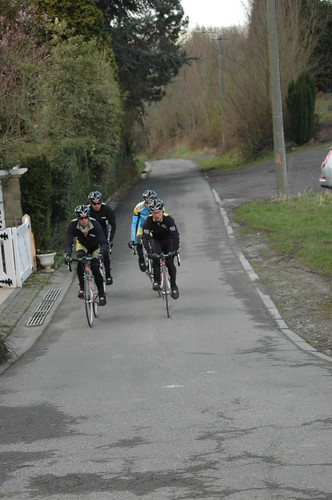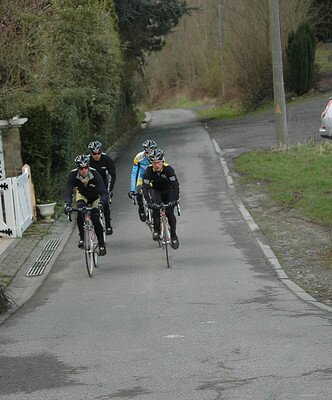March 30, 2011 by Irish Peloton
Is the Three Days of De Panne three days too many?
Over the past number of days, I’ve had a couple of conversations with people, debating whether riders who are serious about the Tour of Flanders should be riding the Three Days of De Panne. It consists of four stages spread over three days, and after it concludes tomorrow, there are only two days to rest up before the Tour of Flanders on Sunday.
But it’s not so much the lack of respite that is of concern, much more likely to affect riders’ preparation for Flanders is the potential for crashes. It is a race which is notoriously dangerous. The route brings the riders along stretches of very narrow roads, along cobbles and around a plethora of road furniture.

Narrow Flandrian roads (via flickr.com)
Just ask Leif Hoste, a three-time runner-up in the Ronde, how dangerous the Three Days of De Panne race can be. As the race narrowed into a bottleneck at the front, Hoste was caught in a crash at the back and now has less teeth in his head than he did this time yesterday. He will be cursing the fact that he didn’t play things conservatively this week and give the Three Days of De Panne a miss.
Indeed, many of the big favourites for Flanders at the weekend have been training rather than racing this week. The likes of Boonen, Flecha and Gilbert have all been rested in the run up to Sunday. Cancellara’s Leopard-Trek team has decided to sit-out the race altogether, as has the Garmin-Cervelo team of Hushovd, Haussler and Farrar.
However, there are a number of riders who should feature in the Tour of Flanders who have decided to risk the few extra days racing to hone their form, e.g. Ballan, Pozzato and Devolder. But to answer the question over whether riders should risk the Three Days of De Panne or not, I’ll do what I do best and look at what the past has to tell us, so let’s find out…
![]() I’ve taken a look at the last ten years of the Tour of Flanders and how each rider who finished in the top 10 prepared in the run up to this monument classic. Last year, the racing calendar changed which meant Ghent-Wevelgem moved from the Wednesday after the Tour of Flanders to the Sunday before, so 2010 (and 2011) have a had a slightly different build-up from previous years. But from 2001 to 2009 each competitor in the Tour of Flanders could ride a combination of Dwars Door Vlaanderen, E3 Prijs, Brabantse Pijl (all one-day races) or the Three Days of De Panne as preparation. So for the top 10 of the Tour of Flanders in the past ten years, how many rode the Three Days of De Panne and how many didn’t? Drum roll please….
I’ve taken a look at the last ten years of the Tour of Flanders and how each rider who finished in the top 10 prepared in the run up to this monument classic. Last year, the racing calendar changed which meant Ghent-Wevelgem moved from the Wednesday after the Tour of Flanders to the Sunday before, so 2010 (and 2011) have a had a slightly different build-up from previous years. But from 2001 to 2009 each competitor in the Tour of Flanders could ride a combination of Dwars Door Vlaanderen, E3 Prijs, Brabantse Pijl (all one-day races) or the Three Days of De Panne as preparation. So for the top 10 of the Tour of Flanders in the past ten years, how many rode the Three Days of De Panne and how many didn’t? Drum roll please….
50% 50%
did didn’t
So, out of 100 instances of riders over the past ten years, exactly half decided to ride a dangerous three day race before the Tour of Flanders, and exactly half decided to go training instead.

Alessandro Ballan on his way to winning the Tour of Flanders having won the Three Days of De Panne a couple of days behind.
Out of the ten winners of the Tour of Flanders since 2001, all but three have ridden the Three Days of De Panne. Devolder (twice), Ballan, Boonen, Wesemann, Van Petegem and Tafi all rode it. The three that didn’t, are Cancellara last year, Boonen in 2006 and Gianluca Bortolami in 2001. Of the seven Ronde winners that did rid in De Panne, three managed to actually finish in the top 10, which shows that you can still be competitive in the Three Days of De Panne if you harbour ambitions for the Tour of Flanders.
In 2007, Alessandro Ballan proved this beyond doubt by actually winning both races, as did Peter van Petegem in 1999.
So, it seems whether you ride the Three Days of De Panne or not, doesn’t seem to matter at all if you want to be competitive in the Tour of Flanders, unless of course you crash and injure yourself. Although racing in Belgium seems more dangerous than anywhere else, riders need preparation. The Tour de France contenders don’t skip the Dauphiné or the Tour de Suisse because they might get hurt. Similarly, riders don’t avoid Paris-Nice and Tirreno-Adriatico in the build up to Milan San Remo.
Gone be the days when Sean Kelly would ride the Tour of Flanders on the Sunday, finish runner up. Then go and ride the Tour of the Basque Country which started the next day, ride six stages in five days and win three of them and the overall. Then back to Northern Europe two days later to ride Paris-Roubaix and win that too. And sure why not folly that up by winning Liége-Bastogne-Liége the following weekend for good measure?


irishpeloton - March 31, 2011 @ 10:02 am
To further support the notion that riding the Three Days of De Panne can be used effectively for Tour of Flanders preparation:
There are 19 teams which are riding both races this year. There’s 8 riders to a team in both races, that’s 162 riders. Of those 162 riders on those 19 teams who are currently riding in De Panne, 83 of them are due to take part in the Tour of Flanders. Which again, is almost 50/50, well, it’s 51.2 to 48.8 to be more accurate.
Interestingly, only one team is due to send the exact same team to the Tour of Flanders as rode the Three Days of De Panne. That is Liquigas. To a lesser extent the same is true for Astana who only sent seven riders to De Panne, instead of the full compliment of eight, and all seven of those are also due to ride the Tour of Flanders.
Also, the only rider on the BMC team who will ride both races is Alessandro Ballan himself, who has called it a day in De Panne choosing not to ride the two stages today.